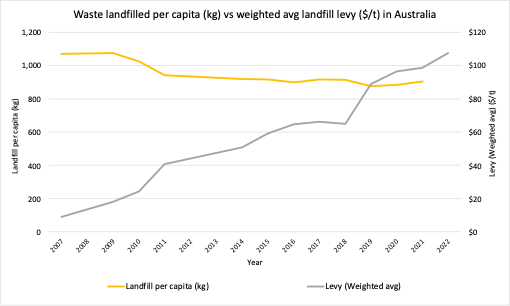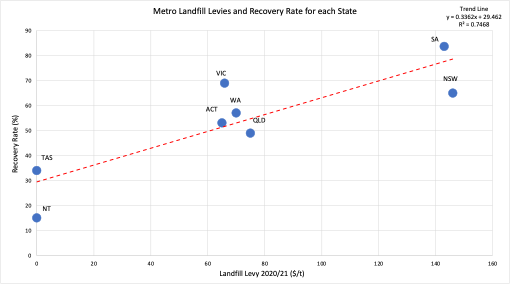Waste myth #3: Landfill levies don’t work

By Mike Ritchie, Director, MRA Consulting Group
Waste is like a river that flows downhill to the cheapest price. If the cheapest option is landfill, then that is where it is going.
Some people like to say that waste is not “waste” but a resource. True in the sense of material resources but not in terms of economics.
Waste, by definition, is “unwanted” in the mind of the generator. (That is how waste is defined in most legislation.) It means, in practical terms, that the owner wants to get rid of it at the least cost possible.
It has negative value. The owner will pay someone to take it away.
If the owner was paid for it, we would call it a second-hand good. It would be for sale on Gumtree or eBay.
Economics (or inherent value) is the difference between waste and second-hand goods. Self-evident?
Think old furniture. If it can be reused, it is most often sold on eBay for a price and the buyer comes and picks it up.
Compare that to broken, old furniture. No value. In fact, negative value. The owner pays a waste company to come and take it away.
That waste company will try to dispose of it in the cheapest way possible. And if that is a landfill, that is where it is going.
It doesn’t matter that it contains reusable wood or metal or hinges etc, when the overall cost to recover those materials (e.g. collection, labour, sorting) is more than the materials are worth, it is waste.
So, ‘What is waste?’ is, by definition, an economic question.
And therefore, if we’re going to fix our waste problem, we need to start with the economics in mind.
Waste will go to the cheapest option. If we can make the cheapest option recycling, then it will go there. If it is landfill, it will go to landfill. Simple.
Tweet
And that dear reader, brings us to the landfill levy.
Landfill levies push up the relative cost of landfill to reflect its unpriced externalities (odour, noise, traffic, resource depletion, greenhouse gas emissions etc) and to drive behaviour change.
They achieve the latter by making the relative cost of landfilling higher than the relative cost of recycling.
Suddenly, recycling is a viable economic solution for disposal of ‘waste’.

And it works.
Levies are the most important recycling and circular economy tool in the current toolbox.
Figure 1 clearly shows that the per capita waste to landfill has decreased in direct proportion to the rise in State landfill levies. There is noise in the data and a lag between rising levies and behaviour change (due, I believe, to the delay in getting sorting and processing infrastructure approved and built).

MRA has analysed the regression analysis between State recovery rates and landfill levies and shown that 70% of the growth in recycling in Australia in the last 20 years can be explained by the rise in landfill levies.
Another startling piece of evidence of the power of levies was the Queensland levy debacle. In 2013 the then Newman State Government removed the existing $35/t landfill levy and unwittingly created an arbitrage opportunity for Sydney waste. 1.4 million tonnes/year of NSW waste was transported by truck and train from Sydney to Brisbane to take advantage of the suddenly cheaper landfill disposal options.
That river of waste was only plugged when the current government re-introduced a levy, at $75/t this time. The flood has fallen to a trickle.
No other policy instrument has had the effect that Australia’s landfill levies have. Of course, it would be remiss of me not to say that regulations or outright bans on landfill would be equally, if not more effective. But State Governments have so far shown little appetite for bans to landfill. EPR systems also work but so far they have been limited to specific small waste streams such as mobile phones, drink containers or TVs. Similarly, no government has yet introduced economy wide taxes on virgin material use or tax subsidies for the use of recycled content in new materials. So, the levies remain our best current approach.
How high should the levies be?
Australia has a weighted average landfill levy of $105/t and with that we recycle 60% of waste materials. Clearly to get to 80% (the agreed national target by 2030) we need to ramp up policies and regulation.
There is no ‘right’ landfill levy value, but we know it needs to be higher than the current levels to drive an uplift in recycling. It needs to be high enough to drive the behaviour change we need. At this time, that is to achieve an 80% diversion from landfill by 2030.
I have suggested that we start lifting levies towards a national uniform levy $200/t. We can observe the rate of behaviour change on the way and tweak the policy on the go. I suggest every government lift the levy by $4-10/t above CPI per year for several years. That will get us there quickly.
I also suggest that 100% of the increases on current levy value be hypothecated to waste / recycling and local government infrastructure and services.
This would drive a strong positive feedback loop between increases in the levy and increases in recycling services.
My final point on the levy is to respond to the criticism that a levy is yet another tax. Yes, it is. It is a tax on landfill, and it is a worthy (and progressive) tax. We know that price signals work.
Tweet
I would also suggest that State Governments use this mechanism as a way to progressively wean themselves off pokie taxes, stamp duty or payroll tax. If we are going to pay tax, let’s at least pay a tax that delivers jobs and other positive outcomes for society and the environment.Landfill levies work. We need to keep going if we are to have any chance of achieving the national waste targets.
Mike Ritchie is the Managing Director at MRA Consulting Group.
This article has been published by the following media outlets:




